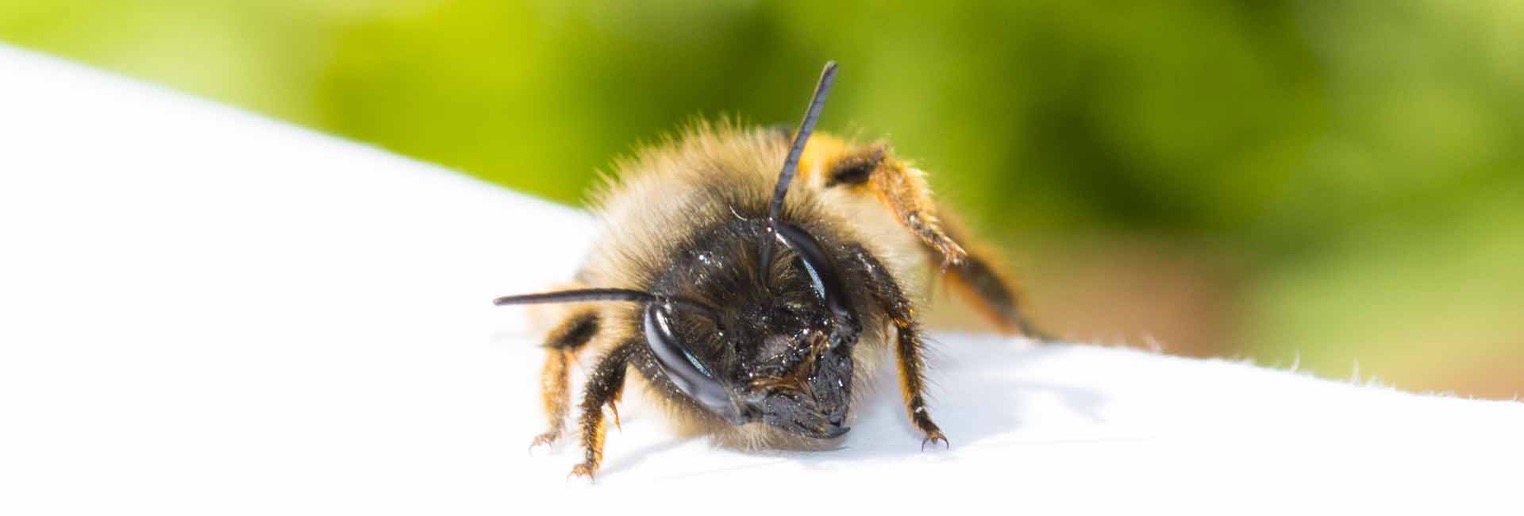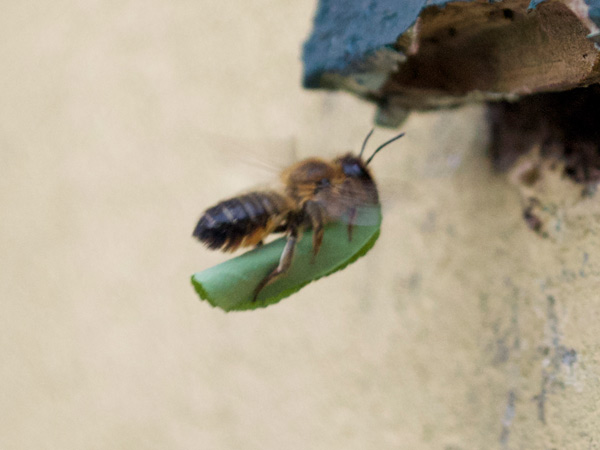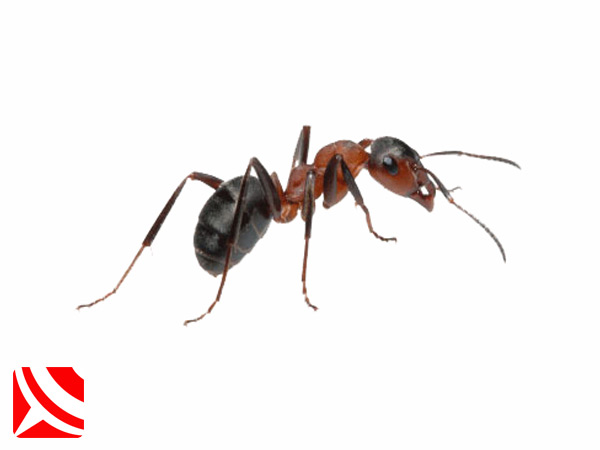Masonry Bees (Genus - Osmia: Family Megachilidae) are bees that build nest cells out of mud within masonry and other hollow, soft and sandy material.
Over many years these holes or tunnels become extensive galleries that allow rain and other problems to penetrate the buildings structure, making control imperative to avoid extensive remediation costs.
What Are Mason or Masonry Bees?
Masonry bees or mason (mortar) bees as they are also known, are a common species of solitary bee, meaning they don't live in a social colony with a queen and workers like honey bees.
Masonry bees are best known and named for their propensity to attack the old or badly maintained mortar or cement between the bricks of our homes. They create or make use of existing horizontal, cylindrical holes in which they complete their life-cycle.
Bees like these also nest in many other areas where damage to mortar does not occur, like roofs, window frames, timber and air bricks.
In the UK we have around twenty species of masonry bee, but we only see around six species in abundance. Population densities of each species are also highly localised, so each new location we visit seems to have a particular species that dominates.
Although they are best known for causing trouble in walls, mason bees are also very active on roofs where they build their galleries between and under the tiles.
In situations like this the bees cause very little if any damage, and should be considered less of a problem, unless large numbers migrate onto surrounding walls and mortar.
Bees discovered entering or attacking the soft mortar of stone and brick walls are described as "economically important", especially in cases where large numbers of these bees are present.
In the short term most activity can be ignored, but over time populations will increase and proliferate in the affected cement mortar, so proactive control in advance of this should be strongly considered
When Are Masonry Bees Active?
Masonry bees are most active and problematic, from early spring through to mid summer (May to July) and are commonly confused with honey bees and wasps. Occasionally we do see another brood of bees later in the year (usually September), but this depends on the prevailing weather conditions, and does not always happen.
Masonry bees prefer sheltered, south facing walls and roofs that receive consistent levels of sunshine. The bees can appear and disappear at an alarming speed. It often seems that as soon as the sun goes in, so do the bees, which might help explain the frantic activity that occurs while the sun is out, and at its most intense.
Are Masonry Bees Dangerous?
Masonry bees do have a sting and we have reports "every year" from our customers describing how they or their children they have been stung by these bees. We often get told they never sting, but we speak to the people that do get stung and not just the people who love bees! This makes our experience far more balanced.
Sometimes the bees are seen in large numbers, causing distress to people afraid of bees or are allergic to stings. The frantic flying behavior of the bees during mating can be a concern, and it sometimes appears as if the bees are swarming.
In general, a couple of bees is not much to be concerned about - however if you have dozens of bees, the likelihood that people with delicate skin might receive a sting, will of course increase.
Where stings have been reported, the stings have not been left in, like those of the honey bee and have not caused significant adverse reactions - only pain and reddening of the skin that has subsequently faded without professional medical intervention.
What Should I do If I'm Stung?
What Damage Do Masonry Bees Cause?
There are many different kinds of Masonry Bee in the UK, but all can cause damage to structures. In most cases this damage is only slight, but in a small percentage of cases, this damage is significant, requiring structural repairs that can cost thousands.
Although these bees are considered solitary, they do in fact seem to re-nest in the place they developed, meaning that populations remain in place for decades. In many cases it is only once a new owner takes over a property that a problem is identified and eliminated.
Masonry bee activity is commonly missed on survey reports, especially where the survey was carried out in the cooler months of the year or a rainy day!
As each new brood matures, ever greater numbers of bees seem to be present at that location with a large number of bees sharing the same entry holes, but using different nesting chambers.
Over many years this damage can reduce the weather resistance of a property, allowing water to penetrate the fabric of the building along with other pests!
Once moisture has penetrated the walls it makes damage even more likely in frosty and icy conditions, and this additional damage only crates additional opportunities for the spring time bees to take advantage of.
Are Masonry Bees Easy To Control?
Getting rid of masonry bees in your walls is not as simple as it seems. This is because each hole needs to be filled, treated or both, and many bee infestations involve hundreds of holes requiring pest control activities to eliminate and prevent bees that have been cause for concern.
Repairing the mortar is a solution, but sometimes causes newly hatched bees to emerge internally - so they end up inside your home!
Where masonry bees are present in other places, especially under the tiles of some roofs, they are almost impossible to eliminate safely without significant cost, pesticide use and structural intervention. Bees in smaller concentrations are far easier to control if absolutely required.
Where it is necessary to tackle the bees head on, there are a few things we can do to help. Firstly insecticidal dusts can be used, and secondly rapid set mortar can be used to re-point the damaged mortar.
Mortar needs to be applied with a pointing gun if possible, because the narrow, deep holes created by the bees are almost impossible to re-point properly using a trowel.
The reason we use mortar that sets quickly is to avoid the bees eating through newly applied standard mortar that remains soft for a prolonged period.
For this reason proofing and remediation works should be scheduled for the cooler months of the year when the bees are not active, and this also reduces the likelihood of people being stung by some of the larger species of masonry bees.
Bonding agents and hardeners can also be applied with a brush or sprayed directly onto affected mortar, making it far more difficult for bees to penetrate.
Silicon sealant is also effective around window and door frames. Timber frames that have started to rot might need to be re-mediated or replaced for control measures be effective as the timber is no match for the mason bees powerful mandiblesDon't fall for the conservation advice. Buying alternative accommodation for the bees in the form of bee houses full of ready made bamboo, reed and straw holes, will offer no guarantee that these bees will not eventually migrate onto the adjoining mortar.
For best results, place these bee houses away from the main building where they can do all their good stuff without being tempted by your property!
Getting Rid Of Masonry Bees - is it legal?
Yes - The damage caused, makes them a pest of economic importance - they have no legal protection, so don't fall the advice found online to contrary. If in doubt always ask the author to direct you to where it states in law that masonry bees have legal protection.
As we have always maintained, the use of pesticides should be seen as a last resort as these chemicals are non specific in action, meaning they kill almost all species of insect - good and bad! For this reason you should always seek accredited professional advice.
Common Places Masonry Bees Nest
Masonry Bees Are Common In Window Frames and UPVC window Vents.
As you can clearly see in this image, the mud cells are packed with pollen and nectar. Each cell within the brood chamber contains one, but sometimes three eggs that hatch into larvae and develop over the coming six to twelve months, to emerge in the autumn or following spring.
Usually we see around six to ten cells, but these are not always the work of one female so estimates and true numbers can be highly variable depending on factors that include, climate, food availability and population density.

Masonry Bees In Air Bricks Are A common Sight.

Masonry Bees Between Roof Tiles Can Become Swarms.

Do Masonry Bees Produce Honey?
No - They are solitary, not social and are different in a number of ways to Honey Bees. Because manson bees are not active as a colony, the social machinery is not available to produce honey at scale. Instead mason bees collect pollen and create cells with mud in siutable cavities, like those pictured above.
Local Service Areas Our Pest Control Service Covers
Bristol - Clevedon - Portishead - St Annes - St Pauls - St George - Sneyd Park - Fishponds - Eastville - Easton - Frenchay - Filton - Westbury - Stoke Bishop - Stoke Park - Southville - Long Ashton - Patchway - Bradley Stoke







